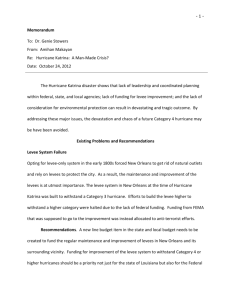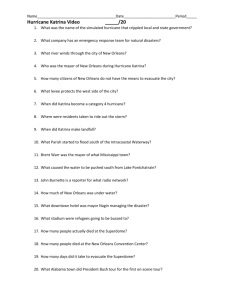first part
advertisement

Introduction Introduction Background Solutions: Environmental and Engineering Intermission Solutions: Social and Political Conclusion Background Introduction Background Solutions: Environmental and Engineering Intermission Solutions: Social and Political Conclusion Geography of New Orleans Hurricane Katrina Environmental Issues Alternative Plans 100 Year Plan New Orleans Geography Lake Pontchartrain (north) Lake Borgne (east) Mississippi River (through the city) Gulf of Mexico (south) Wetlands (southeast) Environmental Concerns Elevation– from 2 m above to 5 m below sea level Mississippi River bed is rising Subsidence– 5-8 mm per year Reduction of Wetlands– 75 sq. km per year Sea Level Rise– 11 cm to 77 cm in 100 years Global Warming Hurricane Katrina Made landfall as a Category 3 in southeastern Louisiana Sustained winds of 125 mph Projected storm surge of 28 ft On August 28th, Mayor Ray Nagin enacted the first mandatory evacuation plan Superdome housed 26,000 people Storm surge caused several levee breaches and flooded city Overall death toll: 1,800 Government Response Response was slow and inefficient FEMA mobilized 1000 Homeland Security workers Firefighters and ambulance crews not allowed in immediately Federal government lacked sufficient devastation information Problems with looting Superdome became a humanitarian crisis Search and rescue efforts were uncoordinated Increasing Hurricane Intensity Hurricane Betsy - 1965 81 casualties $1.4 billion Hurricane Camille - 1969 335 casualties $11 billion Hurricanes Katrina and Rita - 2005 2,000 casualties $105 billion Looking 100 Years Into The Future The Possibilities & The Final Proposal The Possibilities Rebuild and Improve Abandon North Shore Plan The Final Proposal Rebuild and Improve Rebuild better than pre-Katrina High cost High risk Preserves unique New Orleans culture Maintains economy Abandon Deemed too risky to live in Organized relocation of citizens Low cost Low risk The North Shore Preserve unique portions Historical Economic functions Relocate residents to St. Tammany Parish Make New Orleans a commuter city High risk on North Shore also Lack of available land The Final Proposal Downsize to historical sector Move major port functions Port of South Louisiana Baton Rouge New hurricane and flood protection system Citizens’ Relocation Committee (CRC) Use river to develop wetlands The Final Proposal Incorporates the best from the other possibilities Preserves historical sector Provides for relocation of port economy CRC provides for safety of suburban residents Smaller region to protect Lower long-term cost Lower risk Solutions: Environmental and Engineering Introduction Background Sea Level Rise Solutions: Wetlands Environmental and Rivers Engineering Flood Protection System Intermission Solutions: Social and Political Conclusion Global Warming Increase in temperature Caused by emission of greenhouse gases Affect on sea level rise: Thermal Expansion Melting glaciers, ice caps Changes to hydraulic cycle Sea Level Rise Range: 10 cm to 100 cm (IPCC Third Assessment Report) Median: 48 cm Models used: CCCma, GFDL, HadleyCM3, MPI Uncertainty of Sea Level Rise Do not capture multiple climate effects Uncertainty in heat uptake by deep ocean Timescales lead to inaction in policy Kyoto Protocol Subsidence Types of: Endogenic – caused by human activities Exogenic – caused by natural processes Causes: Groundwater withdrawal Petroleum extraction Tectonic motion Cost of Sea Level Rise $20 - 150 billion if sea levels rise 100 cm (Pugh, 2004) $370 million dry land damages $893 million for wetlands damage $200 - 475 billion for coastal stabilization $57 - 174 million in transient costs 1500 damaged homes yearly (McCarthy, 2001) Louisiana’s Wetlands: Functions Commercial importance Produces 1/4 of the nation's oil and natural gas Produces 1/3 of the nation’s fisheries’ landings Hosts 2nd largest wildlife habitat in the U.S. Protective importance Protection against storm surges Every 3-4 linear miles of healthy wetlands reduces storm surge by 1 foot Long Term Reduce and compensate for current rate of loss of 75 square kilometers per year Prepare for sea level rise Maintain barrier islands Improve knowledge of ecosystem dynamics and restoration technology Wetlands Problems and Solutions Draining and Filling Zoning laws Canals and Channels Use fewer canals Prevent further erosion from canals Erosion Barrier Islands Use of dredged sediments Revegetation River diversions Draining and Filling Proposed Legislation: Prohibit draining and filling of ecologically important wetlands 100 foot buffer between wetlands and developed areas Best management techniques for drilling and farming Canals Small Scale Canal Impact Canal dredging Human-altered hydrology and substrate collapse Large Scale Canal Impact Deep navigation canals Pipelines 8,000 miles of pipelines across coastal Louisiana Barrier Islands Katrina’s destruction of Chandeleur barrier islands (approximately 50% loss) Present-day: slow rate of recovery Immediately: dredging Sand deposits of previous delta lobes (i.e. Ship Shoal) Dredged Sediments-Marsh Sediment pumped into or placed on shallow water areas Increases elevation of marshes or creates new marsh Mixed success May become more important in the context of increased sea level Revegetation Major plant death Salt water intrusion Lack of nutrients Stabilization of soil Species must be well-adapted to predicted conditions Spartina can tolerate moderate salinity River Distributaries Dredged sediments and revegetation are inefficient to continue long term Sediment and nutrient delivery system Raise elevation Counteract subsidence Revive ecosystems to reduce erosion Distributaries Two distributaries Each divert up to 1/5 of normal river discharge Floodgate at entry point to control water level Open wider during floods Open less during low water Armored banks Distributaries EAST: Breton Sound Fill in MRGO until Violet Canal Violet Canal and MRGO form distributary WEST: Barataria Bay Wilkinson Canal forms distributary Establish Barataria Waterway as main canal for Lafayette oil and gas field Cutoff Southern cutoff 2 crevasses between cutoff and Buras – maintain navigation, not flood control No levees below Buras – navigation channel will not be maintained Entry Point: Buras Buras to replace Head of Passes as main entry point to deep draft channel Two navigation canals will allow entry from east and west Bird-foot delta abandoned; nothing south of Buras unless built on a deepwater platform Problem: Riverbed Rise Riverbed rise Sediment builds up on riverbed because it cannot be distributed on floodplain Increasing stress on Old River Control Structure Maintains 70% discharge through current Mississippi River channel Dredging River currently being dredged to maintain navigation channel Very costly but feasible because of economic importance of river Wing Dams Wing dams: dikes that extend from a river’s banks while allowing water to flow unhindered through the middle of the channel Water behind dams will slow and drop sediment, building up sediment behind the dam River channel will narrow and deepen Wing Dams, cont. Increased current velocity and pressure on bed will increase erosion, promote self-scouring process to bring bed level closer to sea level River banks must be armored, so that increased erosion occurs on the bottom and not the sides New river entry point at Buras shortens horizontal distance, allowing erosion to steepen profile New River Specifications Below Baton Rouge maintain 500 ft wide main channel, wide enough to accommodate riverboat traffic Between Port of South Louisiana and Wilkinson Canal maintain 650 ft wide main channel, to accommodate the traffic at Port of New Orleans, especially boats turning around Old River Erosion of bed closer to sea level will decrease height difference between Atchafalaya and Mississippi beds at Old River, currently 12-14 ft Material will be dredged from behind Old River to match changing elevation of Mississippi River bed Increases capacity and use of existing structure for flood control Flood Protection System Plans Filling in the Mississippi River Gulf Outlet Floodgates and double pumps on the 17th Street, Orleans Avenue, and London Avenue Canal Levees Levee Reconstruction Monitoring and Maintenance Filling-In the Mississippi River Gulf Outlet Storm surge coming up outlet was intensified, causing levees to be breached Filling-in protects against funnel effect Commercial/industrial impact Floodgates and Double Pumps Floodgates stop water from coming into the city through the canals Gates close when storm surge threatens Governance by NOAA Increase and redesign pump system throughout city Levee and Floodwall Reconstruction Patchwork system Levees poorly monitored Subsidence I-walls protecting Lower Ninth Ward New Orleans East levees overtopped and eroded I-walls were not able to handle pressure from storm surges Scouring and seepage caused some I-walls to fail Foundations were poor Solutions Rebuild to withstand Category 5 hurricane: Replace I-walls with T-walls Selective levee armoring Rolled clay levees Replace poor foundations with compacted soil New levees from Intracoastal Waterway to Jefferson West Levee System Monitoring and Maintenance Levee Governance Board Yearly levee inventory Differential Global Positioning System to monitor subsidence Role of Army Corps Timeline Floodwalls and levees raised to approved heights and engineering errors fixed. 2010 Nov 2006 Sept 2007 Temporary floodgates on canals. 220 miles of levee repaired. Flood Protection System complete. Intermission Introduction Background Solutions: Environmental and Engineering Intermission Solutions: Social and Political Conclusion Absorbing the Information The 100 Year Plan Environmental and Engineering Issues Sea level rise and subsidence Wetlands Mississippi River Flood Protection System Solutions: Social and Political Introduction Downsizing/Zoning Background Ports/Jobs/Relocation Solutions: Social/Cultural Environmental and Engineering Intermission Solutions: Social and Political Conclusion Insurance/Building Codes Evacuation Costs Committee for Continued Monitoring Downsizing By District What Do We Do Now? Risk of subsidence, sea level rise, increased storm surge Returned population- 190,000; 43% of the 2004 population of 440,000 Residents rebuilding Repair Hurricane Protection Systems- $300 million spent by Army Corps of Engineers Lakeview and Gentilly Safe in the short term Repaired Hurricane Protection Systems: $170 million spent by Army Corps of Engineers Plans for another $120 million in future projects Necessary for general protection of city Will be zoned over 50 years 50 Year Zoning Plan Time Zoning Law Immediate No new house construction 5 years No household additions 10 years No immigration Criteria for Clearing Neighborhoods Time Occupancy Immediate <5% 30 years <10% 35 years <15% 40 years <20% 45 years <25% 50 years All evacuated from selected neighborhoods New Orleans East, Venetian Isles, Village de L’Est Severe damage and high subsidence rates Would not be safe if another, similar hurricane hit Significant additional costs to make these areas safe $67.5 million spent $232.5 million planned Eminent domain, “full and just” compensation Lower Ninth Ward Considerable damage: 82% of homes had at least $5,200 in damages Subsidence rate of 5 mm/year Average elevation 0.9 meters above sea level Returned population of 5% Suitable for rebuilding Remaining districts in Orleans Parish will be preserved Plaquemines 57 % of homes sustained greater than $5200 in damage 13 mm per year subsidence rate Downriver from Pointe a la Hache immediate evacuation Between Wilkinson Canal and Pointe a la Hache—50 Year Zoning Plan Other Uses for Land Research Area Wetlands Alternate Energy Sources Wildlife Reserve Port Functions Port of South Louisiana will take over many of the roles of the Port of New Orleans Shift shipping and trading business out while maintaining tourism Provide monetary incentives for businesses to relocate to Port of South Louisiana Jobs We plan to move businesses to Baton Rouge - Preparing Baton Rouge - Offering incentives for businesses to relocate Most jobs still in New Orleans will be related to tourism Relocating People People will relocate - Zoning and eminent domain in some neighborhoods - Following the jobs to other cities Offer support through the Citizens’ Relocation Committee (CRC) and monetary aid Plans for Preservation Programs Goal: promote cultural awareness Festivals, museums, libraries, and memorials Example: New Orleans Jazz and Heritage Festival New Orleans History Month Preserve a city’s culture while moving on to a safer, more efficient municipality in a new location Social Considerations Completion of clean-up Reopening of funeral homes Beautification of cemeteries Propagation of neighborhood festivals Hurricane and Flood Memorial Education Vocational training Non-academic activities for grade school students Normalize transportation and hours New curriculum: Local cultural and political history Diversity acceptance Hurricane and flood preparedness Conservation and environmentally sound living Insurance Policy Louisiana Department of Insurance clarify insurance ambiguities expansion of agent-homeowner services Mandatory National Flood Insurance Program avoid “natural disaster syndrome” Building Codes and Green Architecture First Floor Plan Minimizes flood damage $5000 contents coverage limit Wind Damage Recommendations Protection of building openings Improved roof-sheathing attachment Improved roof-wall connections Secondary waterproofing to roof joints Green Architecture Government-Subsidized Housing Single family homes and low-rise apartments Follow building codes and green architecture guidelines Integration of mixed income communities Evacuation/Storm Refuge Evacuation Routes Major evacuation routes: I-10 to Baton Rouge/Houston I-55 I-59 to northern Mississippi Contraflow changes inbound to outbound Car Access and Remnant Population Problem Superdome housed 26,000 people 9% of population has no car access Solution: Public bus transportation to common evacuation destinations Set up additional local shelters Staff and supply Superdome with a maximum capacity Baton Rouge Overpopulation Problem Baton Rouge's population nearly doubled with incoming evacuees Solution: Allow only up to 50-100,000 refugees into city LSU as temporary shelter Develop Houston as evacuation destination by designating Astrodome as a shelter and Astrodome/Reliant Center Complex as a health clinic Current Plan: Phase System Phase Location Time Before Landfall (hrs.) Strength of Hurricane 1 South of Intracoastal Waterway 50 Category 1 or higher 2 Between Intracoastal Waterway and Mississippi River 40 Category 2 or higher 3 Between Mississippi River and I-12 30 Slow-moving Category 3 or higher Additions Phase 3 begins contraflow During Phase 1, begin pre-supplying shelters in New Orleans with food, water, and first-aid kits Contract private companies to do so and to stock excess emergency supplies such as flashlights and batteries throughout hurricane season. Evacuation Cooperation 20-30% of New Orleans population failed to evacuate Solution: Remind public of hurricane dangers; increase evacuation cooperation Hurricane Awareness Week Continue to advertise/distribute info pertaining to evacuation routes, home security, bus transport stops Costs of Short-Term Plan Wetland Restoration Levee Repair & Construction Clean-Up and Recycling Acquisition of Land City Planning and Insurance Mississippi River TOTAL $815,558,000 $15,125,000,000 $2,500,000 $6,480,400,000 $1,401,345 $248,855,000 $22,672,313,000 + $500,370 per government subsidized and insured house Costs of Long-Term Plan Wetland Restoration $24,435,000,000 Levee Repair & Maintenance $15,000,000,000 Phasing Out of People and Industry Mississippi River Monitoring and Maintenance TOTAL $40,000,000,000 $3,500,000,000 $82,935,000,000 Committee for Continued Monitoring Experts and professionals from many different fields Provides flexibility to our proposal Keeping New Orleans safe in the future Conclusion Introduction Background Solutions: Environmental and Engineering Intermission Solutions: Social and Political Conclusion Conclusion A plan of integration A downsized, sustainable city A New Orleans for the future Credits We would like to thank Sam Bowring, Rafael Bras, Ari Epstein, Katrina Cornell, our Undergraduate Teaching Fellows, our Alumni Mentors, Debra Aczel, Maria Shkolnik, Ruth Weinrib, and the librarians. We would also like to thank the panelists. Mission 2010: New Orleans






